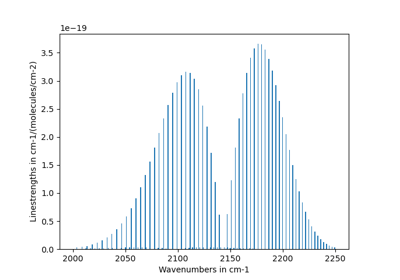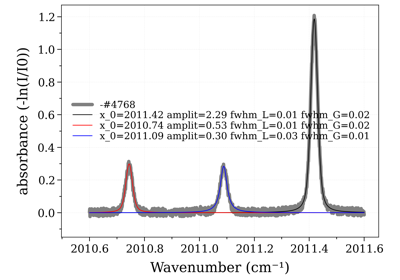radis.levels.partfunc module¶
Partition function calculators and tabulators.
Notes
Partition function calculators and tabulators
Calculators all derive from the same RovibPartitionFunction object, and require a list of energies
Tabulators are more specific, and require a list of precalculated partition functions at different temperature. PartFuncTIPS uses the HITRAN hapi.py [1] module to interpolate Q for HITRAN species
Routine Listing¶
Partition functions:
Which inherit from:
Which inherit from:
See also
-class:
PartFuncCO2_CDSDcalc-class:
PartFuncCO2_CDSDtab
References
- class PartFuncExoMol(name, T_range, Q_range)[source]¶
Bases:
RovibParFuncTabulatorReturn partition function using interpolation of tabulated values.
- Parameters:
name (str) – exomol isotope full name
T_range, Q_range (array) – initial references values to be tabulated.
Examples
One can use
fetch_exomol()which has the option to return aPartFuncExoMolobjectfrom radis.io.exomol import fetch_exomol from radis.api.exomolapi import get_exomol_database_list print(get_exomol_database_list("SiO", "28Si-16O")) # 'EBJT" is one database _, _, Z_exomol = fetch_exomol("SiO", "EBJT", return_local_path=True, return_partition_function=True) # Get temperature at 2000 K print(Z_exomol.at(2000))
See also
- PartFuncHAPI[source]¶
alias of
PartFuncTIPS
- class PartFuncTIPS(M, I, path=None, verbose=True)[source]¶
Bases:
RovibParFuncTabulatorReturn partition function using interpolation of tabulated values using the TIPS program [TIPS-2020]
- Parameters:
M (int) – molecule id
I (int) – isotope identifier
path (str) – path to
hapi.py. If None, the hapi package from PyPI is used.
Examples
from radis.levels.partfunc import PartFuncTIPS from radis.db.classes import get_molecule_identifier M = get_molecule_identifier('N2O') iso=1 Q = PartFuncTIPS(M, iso) print(Q.at(T=1500))
See online examples for more.
References
Partition function are retrieved from [TIPS-2020] through [HAPI] (Hitran Python Interface) using partitionSum(M,I,T)
- class PartFunc_Dunham(electronic_state, vmax=None, vmax_morse=None, Jmax=None, spectroscopic_constants='default', use_cached=True, verbose=True, calc_Evib_per_mode=True, calc_Evib_harmonic_anharmonic=True, group_energy_modes_in_2T_model={'CO2': (['Evib1', 'Evib2', 'Evib3'], ['Erot'])}, mode='full summation')[source]¶
Bases:
RovibParFuncCalculatorCalculate partition functions from spectroscopic constants, if molecule data is available in RADIS. If using the default spectroscopic constants, make sure you know what reference data is being used in RADIS! Energies are calculated with the
Erovib()method ofMolecules- Parameters:
electronic_state (
ElectronicState) – anElectronicStateobject, which is defined in RADIS molecule database and contains spectroscopic datavmax (int, or
None) – maximum vibrational quantum to calculate with Dunham expansion. If None, the molecule one is taken. If None still, all levels are calculated up to the molecule dissociation energyvmax_morse (int, or
None) – maximum vibrational quantum to calculate with Morse potential. If None, the molecule one is taken. Use0or-1not to calculate with Morse potentialJmax (int, or
None) – maximum rotational quantum. If None, the molecule one is taken. If None, all levels are calculated up to the molecule dissociation energy
- Other Parameters:
use_cached (
True,False, or'regen','force') – ifTrue, use (and generate if doesnt exist) a.h5file. If'regen', regenerate cache file. If'force', raise an error if file doesnt exist. DefaultTruecalc_Evib_per_mode (boolean) – if
True, calculate energies of each vibration mode (so far only implemented for CO2 with Evib1, Evib2, Evib3 but shall be generalized to all molecules)calc_Evib_harmonic_anharmonic (boolean) – if
True, calculate and store separately harmonic and anharmonic parts of the vibrational energy. This is needed to calculate Treanor distributions ( ~ Evib_harmonic / Tvib - Evib_anharmonic / Trot )group_energy_modes_in_2T_model (dict) – (experimental in neq 0.9.21) for polyatomic molecules (> 1 vibration mode), how to regroup energy modes when working with 2T models. For instance, for CO2, (Evib, Erot) could as well as defined with:
['Evib1', 'Evib2', 'Evib3'],['Erot'] or ['Evib3'],['Evib1', 'Evib2', 'Erot']
depending on which levels are supposed to interact the most
mode (‘full summation’, ‘tabulation’) – calculation mode.
'tabulation'is much faster but not all possible distributions are implemented. Default'full-summation'
Examples
Calculate partition function of CO using default spectroscopic constants:
from radis.db.molecules import Molecules from radis.levels.partfunc import PartFunc_Dunham isotope = 1 electronic_state = "X" S = Molecules["CO"][isotope][electronic_state] # Equilibrium partition functions : Qf = PartFunc_Dunham(S) print(Qf.at(T=3000)) # K # Nonequilibrium partition functions : print(Qf.at_noneq(Tvib=2000, Trot=1000)) # K
Examples using
radis.levels.partfunc.PartFunc_Dunham¶Notes
Validity:
So far, RADIS energy levels are only calculated from Dunham’s expansion. Above a certain vibrational level a Morse Potential may be used. See how the molecule is defined in
molecules- build_energy_levels_class1()[source]¶
in the case where only Ediss is given. Deal with vmax, Jmax later.
Applies to molecules in
HITRAN_CLASS1- Returns:
but the Pandas DataFrame
self.dfis updated with parameters:g: degeneracyE: energy levelEvib: vibrational energyErot: rotational energyviblvl: vibrational level name
- Return type:
None
- build_energy_levels_class5(calc_Evib_per_mode=True, calc_Evib_harmonic_anharmonic=False, group_energy_modes_in_2T_model=(['Evib1', 'Evib2', 'Evib2'], ['Erot']))[source]¶
in the case where only Ediss is given. Deal with vmax, Jmax later.
HITRAN_CLASS5= [‘CO2’] # Linear triatomic with large Fermi resonance- Parameters:
calc_Evib_per_mode (boolean) – if
True, calculates Evib1, Evib2, Evib3- Other Parameters:
calc_Evib_harmonic_anharmonic (boolean) – if
True, calculates Evib_h and Evib_a, harmonic and non harmonic components, to be used in Treanor distributionsgroup_energy_modes_in_2T_model (dict) – (experimental in neq 0.9.21) for polyatomic molecules (> 1 vibration mode), how to regroup energy modes when working with 2T models. For instance, for CO2, (Evib, Erot) could as well as defined with:
['Evib1', 'Evib2', 'Evib3'],['Erot']
or:
['Evib3'],['Evib1', 'Evib2', 'Erot']
depending on which levels are supposed to interact the most
- Returns:
but the Pandas DataFrame
self.dfis updated with parameters:g: degeneracyE: energy levelEvib: vibrational energyErot: rotational energyviblvl: vibrational level name
- Return type:
None
- class RovibParFuncCalculator(electronic_state, mode='full summation', verbose=False)[source]¶
Bases:
RovibPartitionFunction- Parameters:
electronic_state (
ElectronicState) – anElectronicStateobject, which is defined in RADIS molecule database and contains spectroscopic data. Energies are calculated with theErovib()method.- Other Parameters:
mode (‘full summation’, ‘tabulation’) – calculation mode.
'tabulation'is much faster but not all possible distributions are implemented. Default'full-summation'
See also
- N_bins_scaling[source]¶
func int, int -> int Reduce number of Bins in each dimension ; in high dimensional spaces. This is justified by accuracy tests in
radis.test.levels.test_partfunc.test_tabulated_partition_functions()
- at(T, update_populations=False)[source]¶
Get partition function at temperature T under equilibrium conditions.
- Parameters:
T (float) – equilibrium temperature
- Other Parameters:
update_populations (boolean) – if
True, store calculated populations in energy level list DefaultFalse- Returns:
Q – partition function calculated at temperature T
- Return type:
float
Examples
See online examples
See also
at_noneq(),at_noneq_3Tvib()
- at_noneq(Tvib, Trot, overpopulation=None, vib_distribution='boltzmann', rot_distribution='boltzmann', returnQvibQrot=False, update_populations=False)[source]¶
Calculate Partition Function under non equilibrium (Tvib, Trot), with boltzmann/treanor distributions and overpopulations as specified by the user.
- Parameters:
Tvib, Trot (float) – vibrational & rotational temperatures (K)
overpopulation (dict, or
None) – dict of overpopulated levels:{'level':over_factor}vib_distribution (
'boltzmann','treanor') – distribution of vibrational levelsrot_distribution (
'boltzmann') – distribution of rotational levelsreturnQvibQrot (boolean) – cf output
- Other Parameters:
update_populations (boolean) – if
True, store calculated populations in energy level list. DefaultFalse- Returns:
Q (float) – partition function calculated at non eq temperatures
Q, Qvib, dfQrot (float, float, pandas table (if returnQvibQrot)) – total partition function, vibrational partition function, and table of rotational partition functions for each vibrational state (note that all Qrot are not necessarily the same for all vibrational levels)
Examples
See online examples
See also
at(),at_noneq_3Tvib()
- at_noneq_3Tvib(Tvib, Trot, overpopulation=None, vib_distribution='boltzmann', rot_distribution='boltzmann', returnQvibQrot=False, update_populations=False)[source]¶
Calculate Partition Function under non equilibrium ((Tvib1, Tvib2, Tvib3), Trot), with boltzmann/treanor distributions and overpopulations as specified by the user.
Dedicated function for 3 Tvib mode
- Parameters:
Tvib, Trot ((float, float, float), float) – vibrational & rotational temperatures (K)
overpopulation (dict, or
None) – dict of overpopulated levels:{'level':over_factor}vib_distribution (
'boltzmann','treanor')rot_distribution (
'boltzmann')returnQvibQrot (boolean) – cf output
update_populations (boolean) – if
True, saves populations for calculated temperature in PartitionFunction dataframe. DefaultFalse
- Returns:
Q (float) – partition function calculated at non eq temperatures
Q, Qvib, dfQrot (float, float, pandas table (if returnQvibQrot)) – total partition function, vibrational partition function, and table of rotational partition functions for each vibrational state (note that all Qrot are not necessarily the same for all vibrational levels)
See also
at(),at_noneq()
- class RovibParFuncTabulator[source]¶
Bases:
RovibPartitionFunction
- class RovibPartitionFunction[source]¶
Bases:
objectGeneral class from which all partition function calculators derive.
- Parameters:
electronic_state (
ElectronicState) – anElectronicStateobject, which is defined in RADIS molecule database and contains spectroscopic data
Notes
Implementation:
one partition function generator (RovibPartitionFunction) is generated per specie per isotope
RovibPartitionFunction may differ in the way they build / fetch their list of states and the associated energies, but the .at(), .at_noneq() calls to calculate the partition function should be shared among all derived classes
See also







